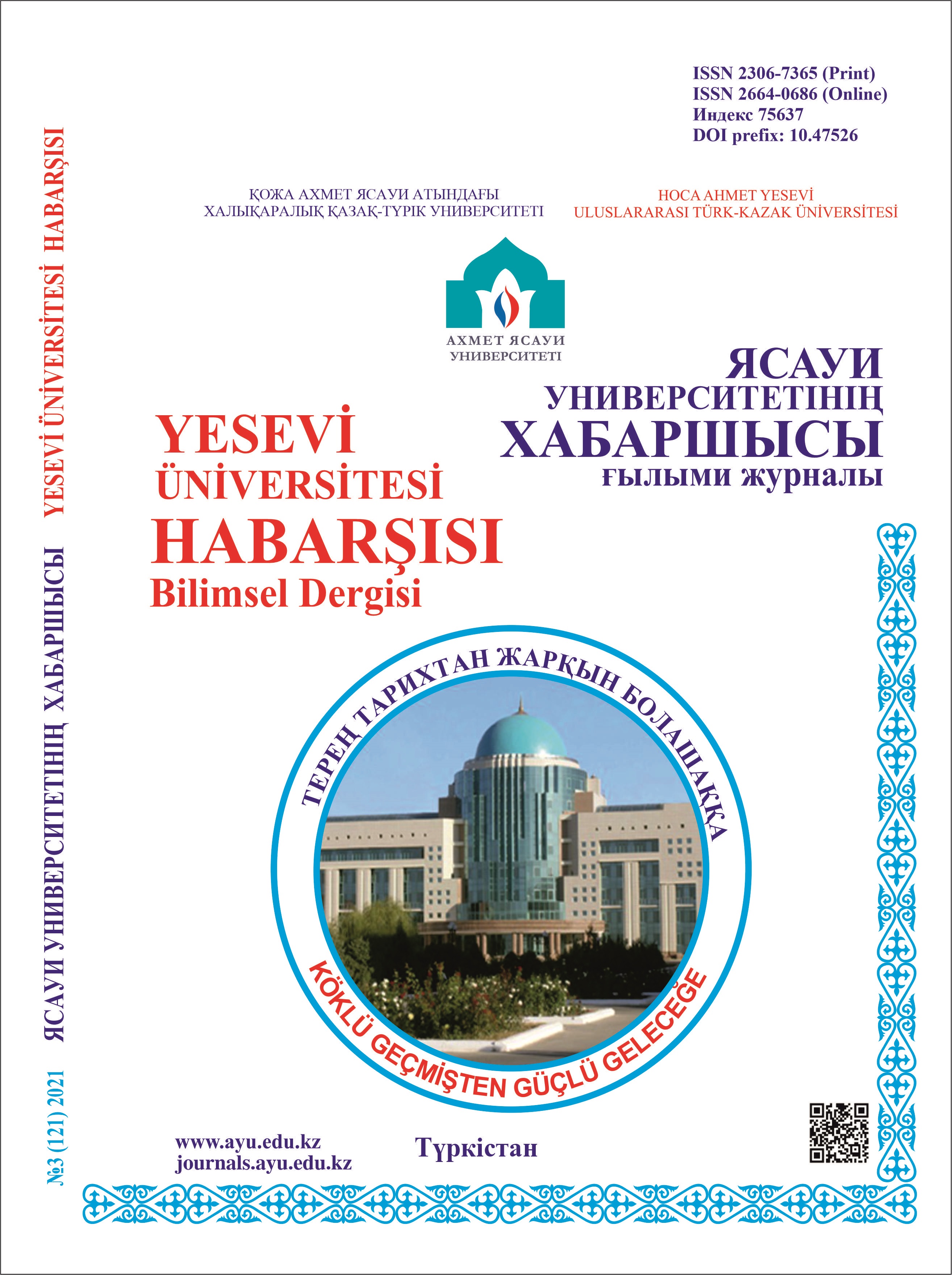Nonverbal Actions in the Kazakh Tradition
127 158
Keywords:
nonverbal techniques, culture, tradition, symbol, communication, background knowledge.Abstract
This article comprehensively examines the nature of nonverbal techniques in the Kazakh tradition. Each nation has its own way of life and customs, rituals and traditions that were formed in accordance with the era in which it lived. Therefore, the nonverbal techniques of each nation are associated with the worldview and culture of this people. In addition to linguistic means of communication, nonverbal techniques also reflect national differences. All the features of the life of this people are preserved against the semantic background of non-verbal techniques based on a national-cultural basis. Therefore, nonverbal techniques that have a national-cultural basis belong to our cultural wealth, which has absorbed the features of the mentality of our ethnic group. Due to these features, the traditional nonverbal techniques of the Kazakh people are considered as a form of cognitive linguistics and ethnolinguistics. This is due to the fact that the semantics of nonverbal techniques, including traditional nonverbal techniques, are not formed simply. Semantics in it is connected with the people’s system of thinking and worldview and acquires a certain symbolic meaning. Thus, based on the experience of an entire nation in the use of language, it is consolidated and acquires a communicative character. In the future, pronunciation becomes stable in form and is transformed into phraseological units. Thus, a national code with a certain information range is formed.
In addition, the article analyzes the connection of many non-verbal techniques based on national traditions with the religious beliefs of the people at certain times. Superstitions are formed from such beliefs among the people. Most of these rituals are considered to be inextricably linked with non-verbal techniques. That is why superstitions and prohibitions occupy a special place in the study of non-verbal techniques related to customs and rituals characteristic of our people and in the recognition of the nation's worldview. Traditional nonverbal techniques are not limited to providing additional information during a communicative act, but also inform about the worldview and knowledge of communicants. The study found that the background of nonverbal techniques lies in the culture and knowledge of the nation. It is for this reason that we consider them (non-verbal techniques) as the national code above. It was determined that all national nonverbal techniques contain visual information and a model of familiarization with the surrounding world.
References
Момынова Б., Бейсембаева С. Қазақ тіліндегі ым мен ишараттың қазақша-орысша түсіндірме сөздігі. – Алматы: Қазақ университеті, 2003. – 136 б.
Нұрсұлтанқызы Ж. Бейвербалды амалдар – қарым-қатынастың маңызды элементі // Қазақ тілі мен әдебиеті. – 2004. – №1. – Б. 111–116.
Байғұтова А.М. «Қазақ әйелі» концептісінің этномәдени сипаты: филол. ғыл. канд. ... диссертация. – Алматы, 2008. – 145 б.
Ислам А. Ұлттық мәдениет контексіндегі дүниенің тілдік суреті (салыстырмалы-салғастырмалы лингвомәдени сипаттама): филол. ғыл. докт. ... автореф. – Алматы, 2004. – 54 б.
Боздағым. Қазақтың жоқтау жырлары. – Алматы: Жазушы, 1990. – 301 б.
Нұрсұлтанқызы Ж. Бейвербалды амалдардың танымдық табиғаты // «Социосфера» ғылыми-баспа орталығы конференцияларының жинағы. – Пенза, 2013. – №56-2. – Б. 18–20.
Құдиярова А.М. Ортақтасу (қарым-қатынас) психологиясы: Оқу құралы. – Алматы, Дарын, 2002. – 40 б.
Адаева Е.C. Киноаударманың түрлері: субтитр және дубляж // ҚарМУ Хабаршысы. Филология сериясы. – 2014. – №4 (76). – Б. 100–106.
Муратова А.Н., Бахтикереева У.М., Мажитаева Ш. Бейвербалды амалдардың зерттелуі және функционалдық қызметі // ҚарУ Хабаршысы. Филология сериясы. – 2023. – №1 (109). – Б. 39–45.
Сағидолда Г.С., Әбдімәулен Г.А. «Бас» компонентті соматикалық фразеологизмдердің лингвомәдени сипаты (түркі (қазақ, татар, башқұрт) және ағылшын тілдері негізінде) // Ясауи университетінің хабаршысы. – 2023. – №1 (127). – Б. 7–21. 11. Kelmaganbetova A., Mazhitayeva S., Ayazbayeva B., Rahymberlina S., Kadyrov Z. The Role of Gestures in Communication // Theory and Practice in Language Studies. – 2023. – 13 (10). – P. 2506–2513.
Momynova B., Beisembaeva S. Qazaq tilindegi ym men isharattyn qazaqsha-oryssha tusindirme sozdigi [Kazakh-Russian explanatory dictionary of gestures and in the Kazakh language]. – Almaty: Qazaq universiteti, 2003. – 136 b. [in Kazakh]
Nursultanqyzy J. Beiverbaldy amaldar – qarym-qatynastyn manyzdy elementı [Non-verbal techniques-important element of communication] // Qazaq tili men adebieti.– 2004. – №1. – B. 111–116. [in Kazakh]
Baigutova A.M. «Qazaq aielı» konseptisinin etnomadeni sipaty [Ethnocultural nature of the concept «Kazak woman»]: filol. gyl. kand. ... dissertacia. – Almaty, 2008. – 145 b. [in Kazakh]
Islam A. Ulttyq madeniet konteksindegi dunienin tildik sureti (salystyrmaly-salgastyrmaly lingvomadeni sipattama) [Linguistic picture of the world in the context of national culture (comparative-comparative linguocultural characteristics)]: filol. gyl. dokt. ... avtoref. – Almaty, 2004. – 54 p. [in Kazakh]
Bozdagym. Qazaqtyn joqtau jyrlary [Kazakh mournful songs]. – Almaty: Jazushy, 1990 – 301 b. [in Kazakh]
Nursultanqyzy J. Beiverbaldy amaldardyn tanymdyq tabigaty [Cognitive nature of non-verbal approaches] // «Sociosfera» gylymi-baspa ortalygy konferencialarynyn jinagy. – 2013. – №56-2. – B. 18–20. [in Kazakh]
Kudiarova A.M. Ortaqtasu (qarym-qatynas) psihologiasy [Psychology of communication]. oqu quraly. – Almaty, Daryn, 2002. – 40 b. [in Kazakh]
Adaeva E.C. Kinoaudarmanyn turleri: subtitr jane dubliaj [Types of cinematography: subtitles and dubbing] // QarMU Habarshysy. Filologia seriasy. – 2014. – №4 (76). – 131 b. [in Kazakh]
Muratova A.N., Bahtikereeva U.M., Majitaeva Sh. Beiverbaldy amaldardyn zerttelui jane funkcionaldyq qyzmeti [Research and functional function of nonverbal operations] // QarU Habarshysy. Filologia seriasy. – 2023. – №1 (109). – B. 39–45. [in Kazakh]
Sagidolda G.S., Abdymaulen G.A. «Bas» komponentti somatikalyq frazeologizmderdin lingvomadeni sipaty (turki (qazaq, tatar, bashqurt) jane agylshyn tilderi negizinde) [Linguocultural character «Head» somatic phraseological expressions (on the basis of turkic (kazakh, tatar, bashkir) and English languages)] // Iassawi universitetinin habarshysy. – 2023. – №1 (127). – B. 7–21. [in Kazakh]
Kelmaganbetova A., Mazhitayeva S., Ayazbayeva B., Rahymberlina S., Kadyrov Z. The Role of Gestures in Communication // Theory and Practice in Language Studies. – 2023. – 13 (10). – P. 2506–2513.

